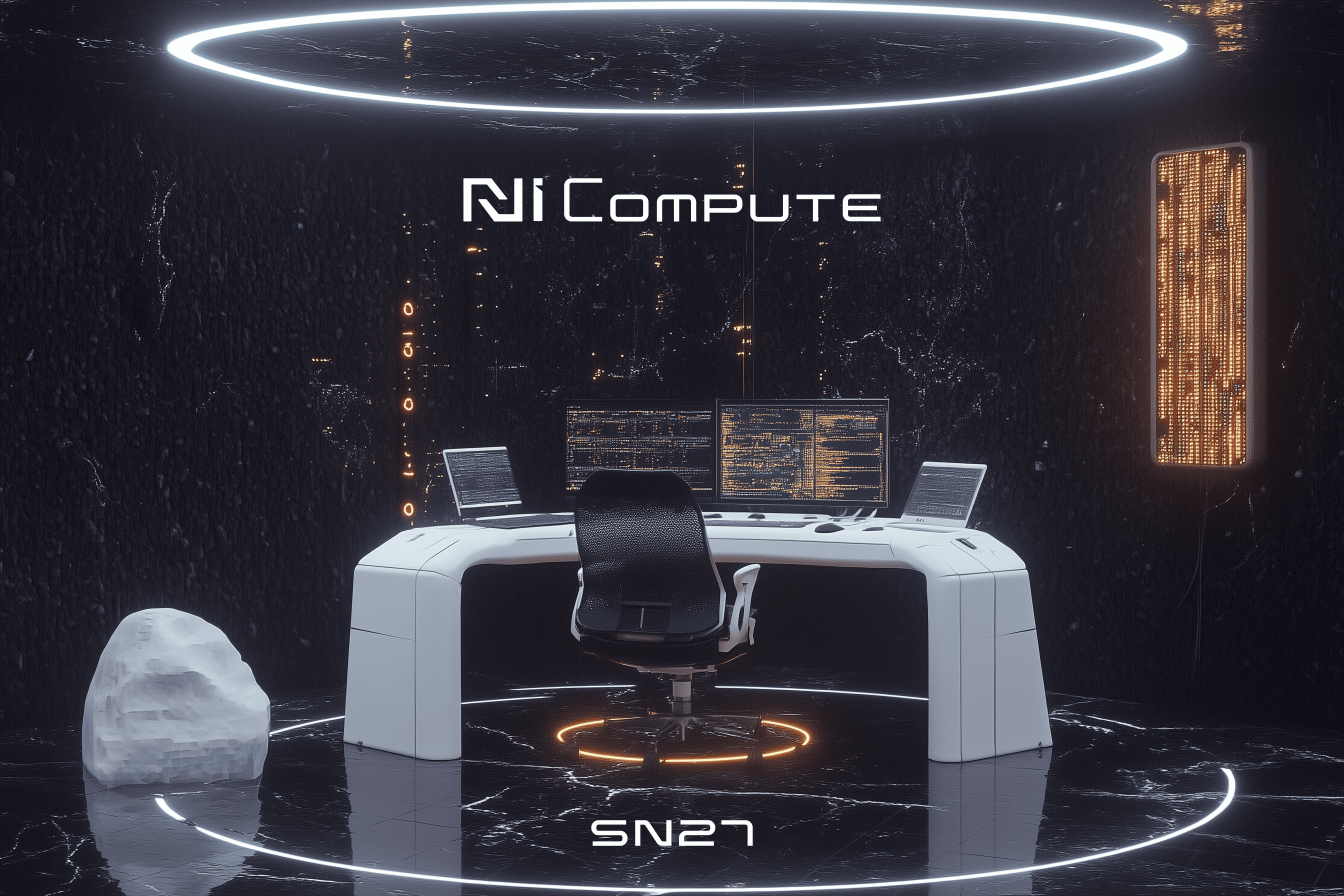Proof-of-GPU: Validation and Incentive Mechanism
Feb 17, 2025

Proof of GPU (PoG): A Novel Validation and Incentive Mechanism for NI Compute (SN27)
Abstract
The exponential growth in artificial intelligence (AI) workloads has created an unprecedented demand for high-performance compute resources. Subnet 27 (SN27) by Neural Internet introduces a groundbreaking mechanism—Proof of GPU (PoG)—designed to validate GPU performance and align miner incentives with real-world computational contributions. Built on the Bittensor decentralized AI framework, PoG leverages GPU-specific metrics such as Tera Floating Point Operations Per Second (TFLOPS) to ensure fairness, scalability, and efficiency. This paper explores the technical architecture of PoG, its integration into SN27, and its alignment with the broader Bittensor ecosystem.
Introduction
The decentralized AI landscape has matured significantly, driven by the demand for large-scale compute resources. However, traditional validation mechanisms like Proof of Work (PoW) and Proof of Stake (PoS) fail to adequately address the unique requirements of AI-centric workloads. Subnet 27 (SN27), a specialized subnet within the Neural Internet ecosystem, seeks to bridge this gap through its novel Proof of GPU (PoG) mechanism.
PoG provides a highly precise, performance-driven approach to validating GPU contributions by leveraging real-time computational metrics such as TFLOPS. This mechanism ensures that GPU resources are optimally utilized, while maintaining fairness and transparency. By integrating seamlessly with Bittensor’s decentralized framework, PoG reinforces the principles of scalability, efficiency, and democratized access to AI infrastructure.
Technical Overview of Proof of GPU (PoG)
Core Objectives
The primary objectives of PoG are:
To accurately validate GPU contributions in a manner reflective of their real-world computational capabilities.
To incentivize the deployment of high-performance GPUs optimized for AI workloads.
To ensure fairness and inclusivity across diverse hardware configurations, from single GPUs to multi-GPU setups.
To align seamlessly with Bittensor’s decentralized AI framework, enhancing its capacity to support large-scale AI research.
Validation Model
The PoG mechanism evaluates GPUs using a set of standardized benchmarks specifically tailored to AI workloads. These benchmarks simulate real-world tasks such as matrix multiplications, inference computations, and training operations.
Key Features of the Validation Model:
TFLOPS-Based Scoring:
Measures computational throughput in terms of floating-point operations per second.
Differentiates between peak theoretical TFLOPS and sustained performance under load.
Provides real-time validation by running workloads directly on miner-contributed GPUs.
Hardware Component Weighting:
The mechanism incorporates scores from auxiliary components such as CPUs, RAM, and storage, ensuring a holistic evaluation.
Multi-GPU and Multi-CPU Aggregation:
Supports setups where multiple GPUs and CPUs operate under a single miner ID, aggregating their performance into a unified score.
Normalization and Fairness:
Scores are normalized against predefined thresholds to ensure inclusivity and prevent over-rewarding extreme configurations.
Benchmark Workflows
The benchmarking process involves:
Matrix Multiplication Workloads: Evaluates the GPU’s ability to handle large-scale matrix operations, a critical component of deep learning tasks.
Floating-Point Precision Tests: Measures FP16 and FP32 throughput, ensuring compatibility with modern AI frameworks such as TensorFlow and PyTorch.
Sustained Performance Metrics: Tracks GPU performance over extended durations to evaluate stability and reliability.
Scoring Methodology
Hardware Weighting
To ensure fairness, the scoring mechanism assigns specific weights to each hardware component based on its relevance to AI workloads:
GPU Contribution (55%): Scores are derived from TFLOPS, memory capacity, and sustained throughput. High-performance GPUs like NVIDIA H100s and A100s are rewarded proportionally for their computational efficiency.
CPU Contribution (20%): Evaluates the total core count and average frequency. Ensures that systems with powerful CPUs are acknowledged for their supplementary compute capabilities.
RAM Contribution (15%): Assessed based on memory capacity (GB) and bandwidth (GB/s). Critical for workloads requiring large datasets or high-speed memory access.
Storage Contribution (10%): Evaluates speed (e.g., MB/s) and capacity (e.g., TB), reflecting the role of storage in data-intensive tasks.
Multi-GPU and Multi-CPU Support
PoG is designed to support large-scale configurations:
GPU Aggregation: Scores from multiple GPUs are summed to produce a cumulative performance metric.
CPU Aggregation: Total core count and frequency are combined to reflect the contribution of multi-CPU setups.
Normalization and Thresholding
Scores are normalized against predefined benchmarks to ensure fairness across hardware tiers.
Thresholds prevent over-rewarding setups with excessive hardware, maintaining equity for smaller contributors.
Incentive Structure
Miner Incentives
Miners are rewarded based on their validated contributions:
Performance-Tied Rewards: Rewards scale with the TFLOPS output and overall hardware contribution. Dynamic adjustments ensure that miners with high-performance GPUs are adequately incentivized.
Dynamic Pricing Mechanism: GPU rental rates are calculated based on real-time benchmarks. Ensures alignment between compute demand and miner incentives.
Validator Incentives
Validators play a critical role in maintaining the integrity of the PoG mechanism:
Inflationary Rewards: Distributed based on stake and validation performance metrics.
Revenue Share
Revenue produced from GPU rentals at the API/platform level will be used to buy back SN27 alpha tokens and burn them, pushing the subnet to aim to be inherently deflationary.
Integration with Bittensor
Synergies with Bittensor
PoG aligns seamlessly with Bittensor’s decentralized AI framework:
Decentralization: PoG’s distributed validation model reinforces the decentralized nature of Bittensor.
Scalability: The mechanism supports diverse hardware configurations, enabling broader participation.
AI Optimization: By prioritizing GPUs optimized for AI, PoG enhances the computational quality available within the Bittensor ecosystem.
Technical Benefits and Challenges
Benefits
Precision: TFLOPS-based benchmarks provide accurate and transparent validation.
Fairness: Weighted scoring ensures inclusivity across diverse hardware setups.
Scalability: Multi-GPU and multi-CPU support enables participation from both individual miners and enterprise-scale contributors.
Transparency: On-chain validation ensures that all scoring and incentive distribution processes are auditable.
Challenges
Validator Complexity: Running real-time GPU benchmarks requires sophisticated infrastructure and optimization.
Normalization Tuning: Setting appropriate thresholds and weights for scoring requires continuous refinement to balance fairness and competitiveness.
Conclusion
Proof of GPU (PoG) introduces a highly technical and performance-driven validation mechanism that aligns with the evolving demands of decentralized AI infrastructure. By integrating seamlessly with Subnet 27 and the Bittensor ecosystem, PoG ensures that computational contributions are accurately measured and fairly rewarded. This mechanism not only supports the growing need for high-performance compute resources but also reinforces the principles of decentralization, transparency, and inclusivity, setting a new standard for decentralized compute networks.
